Mars Helicopter: 6 Things To Know About Ingenuity
Mars Helicopter: 6 Things to Know About Ingenuity

When our Perseverance Mars rover lands on the Red Planet on Feb. 18, 2021, it will bring along the Ingenuity helicopter.
This small-but-mighty craft is a technology demonstration that will attempt the first powered, controlled flight on another planet. Its fuselage is about the size of a tissue box, and it weighs about 4 pounds (1.8 kg) on Earth. It started out six years ago as an implausible prospect and has now passed its Earthbound tests.
Here are six things to know about Ingenuity as it nears Mars:
1. Ingenuity is an experimental flight test.

This Mars helicopter is known as a technology demonstration, which is a project that aims to test a new capability for the first time with a limited scope. Previous technology demonstrations include Sojourner, the first Mars rover, and the Mars Cube One (MarCO) CubeStats that flew by Mars.
Ingenuity does not carry any science instruments and is not part of Perseverance’s science mission. The only objective for this helicopter is an engineering one – to demonstrate rotorcraft flight in the thin and challenging Martian atmosphere.
2. Mars won’t make it easy for Ingenuity.

Mars’ atmosphere is around 1% the density of Earth’s. Because of that lack of density, Ingenuity has rotor blades that are much larger and spin faster than a helicopter of Ingenuity’s mass here on our planet. It also must be extremely light to travel to Mars.
The Red Planet also has incredibly cold temperatures, with nights reaching minus 130 degrees Fahrenheit (-90 degrees Celsius) in Jezero Crater, where our rover and helicopter will land. Tests on Earth at the predicted temperatures indicate Ingenuity’s parts should work as designed, but the real test will be on Mars.
3. Ingenuity relies on Perseverance for safe passage to Mars and operations on the Martian surface.

Ingenuity is nestled sideways under Perseverance’s belly with a cover to protect the helicopter from debris during landing. The power system on the Mars 2020 spacecraft periodically charges Ingenuity’s batteries during the journey to the Red Planet.
In the first few months after landing, Perseverance will find a safe place for Ingenuity. Our rover will shed the landing cover, rotate the helicopter so its legs face the ground and gently drop it on the Martian surface.
4. Ingenuity is smart for a small robot.

NASA’s Jet Propulsion Laboratory will not be able to control the helicopter with a joystick due to delays communicating with spacecraft across interplanetary distances. That means Ingenuity will make some of its own decisions based on parameters set by its engineering team on Earth.
During flight, Ingenuity will analyze sensor data and images of the terrain to ensure it stays on a flight path designed by project engineers.
5. The Ingenuity team counts success one step at a time.

Ingenuity’s team has a long list of milestones the helicopter must pass before it can take off and land in the Martian atmosphere.
Surviving the journey to and landing on Mars
Safely deploying onto the Martian surface from Perseverance’s belly
Autonomously keeping warm through those intensely cold Martian nights
Autonomously charging itself with its solar panel
Successfully communicating to and from the helicopter via the Mars Helicopter Base Station on Perseverance
6. If Ingenuity succeeds, future Mars exploration could include an ambitious aerial dimension.

The Mars helicopter intends to demonstrate technologies and first-of-its-kind operations needed for flying on Mars. If successful, these technologies and flight experience on another planet could pave the way for other advanced robotic flying vehicles.
Possible uses of a future helicopter on Mars include:
A unique viewpoint not provided by current orbiters, rovers or landers
High-definition images and reconnaissance for robots or humans
Access to terrain that is difficult for rovers to reach
Could even carry light but vital payloads from one site to another
Make sure to follow us on Tumblr for your regular dose of space: http://nasa.tumblr.com
More Posts from Sergioballester-blog and Others

The Pale Blue Dot
The “Pale Blue Dot” is a photograph of planet Earth taken in 1990 by Voyager 1 from a record distance, showing it against the vastness of space.
By request of Carl Sagan, NASA commanded the Voyager 1 spacecraft, having completed its primary mission and now leaving the Solar System, to turn its camera around and to take a photograph of Earth across a great expanse of space. Reflecting on this picture (now considered one of the most important pictures in all of human history) Carl Sagan said:
“From this distant vantage point, the Earth might not seem of particular interest. But for us, it’s different. Consider again that dot. That’s here, that’s home, that’s us. On it everyone you love, everyone you know, everyone you ever heard of, every human being who ever was, lived out their lives. The aggregate of our joy and suffering, thousands of confident religions, ideologies, and economic doctrines, every hunter and forager, every hero and coward, every creator and destroyer of civilization, every king and peasant, every young couple in love, every mother and father, hopeful child, inventor and explorer, every teacher of morals, every corrupt politician, every “superstar,” every “supreme leader,” every saint and sinner in the history of our species lived there – on a mote of dust suspended in a sunbeam.
The Earth is a very small stage in a vast cosmic arena. Think of the rivers of blood spilled by all those generals and emperors so that, in glory and triumph, they could become the momentary masters of a fraction of a dot. Think of the endless cruelties visited by the inhabitants of one corner of this pixel on the scarcely distinguishable inhabitants of some other corner, how frequent their misunderstandings, how eager they are to kill one another, how fervent their hatreds.
Our posturings, our imagined self-importance, the delusion that we have some privileged position in the Universe, are challenged by this point of pale light. Our planet is a lonely speck in the enveloping cosmic dark. In our obscurity, in all this vastness, there is no hint that help will come from elsewhere to save us from ourselves.
The Earth is the only world known so far to harbor life. There is nowhere else, at least in the near future, to which our species could migrate. Visit, yes. Settle, not yet. Like it or not, for the moment the Earth is where we make our stand.
It has been said that astronomy is a humbling and character-building experience. There is perhaps no better demonstration of the folly of human conceits than this distant image of our tiny world. To me, it underscores our responsibility to deal more kindly with one another, and to preserve and cherish the pale blue dot, the only home we’ve ever known.”

Juno: Movie of clouds on Jupiter, taken with the JIRAM infrared camera.
Mars Helicopter: 6 Things to Know About Ingenuity

When our Perseverance Mars rover lands on the Red Planet on Feb. 18, 2021, it will bring along the Ingenuity helicopter.
This small-but-mighty craft is a technology demonstration that will attempt the first powered, controlled flight on another planet. Its fuselage is about the size of a tissue box, and it weighs about 4 pounds (1.8 kg) on Earth. It started out six years ago as an implausible prospect and has now passed its Earthbound tests.
Here are six things to know about Ingenuity as it nears Mars:
1. Ingenuity is an experimental flight test.

This Mars helicopter is known as a technology demonstration, which is a project that aims to test a new capability for the first time with a limited scope. Previous technology demonstrations include Sojourner, the first Mars rover, and the Mars Cube One (MarCO) CubeStats that flew by Mars.
Ingenuity does not carry any science instruments and is not part of Perseverance’s science mission. The only objective for this helicopter is an engineering one – to demonstrate rotorcraft flight in the thin and challenging Martian atmosphere.
2. Mars won’t make it easy for Ingenuity.

Mars’ atmosphere is around 1% the density of Earth’s. Because of that lack of density, Ingenuity has rotor blades that are much larger and spin faster than a helicopter of Ingenuity’s mass here on our planet. It also must be extremely light to travel to Mars.
The Red Planet also has incredibly cold temperatures, with nights reaching minus 130 degrees Fahrenheit (-90 degrees Celsius) in Jezero Crater, where our rover and helicopter will land. Tests on Earth at the predicted temperatures indicate Ingenuity’s parts should work as designed, but the real test will be on Mars.
3. Ingenuity relies on Perseverance for safe passage to Mars and operations on the Martian surface.

Ingenuity is nestled sideways under Perseverance’s belly with a cover to protect the helicopter from debris during landing. The power system on the Mars 2020 spacecraft periodically charges Ingenuity’s batteries during the journey to the Red Planet.
In the first few months after landing, Perseverance will find a safe place for Ingenuity. Our rover will shed the landing cover, rotate the helicopter so its legs face the ground and gently drop it on the Martian surface.
4. Ingenuity is smart for a small robot.

NASA’s Jet Propulsion Laboratory will not be able to control the helicopter with a joystick due to delays communicating with spacecraft across interplanetary distances. That means Ingenuity will make some of its own decisions based on parameters set by its engineering team on Earth.
During flight, Ingenuity will analyze sensor data and images of the terrain to ensure it stays on a flight path designed by project engineers.
5. The Ingenuity team counts success one step at a time.

Ingenuity’s team has a long list of milestones the helicopter must pass before it can take off and land in the Martian atmosphere.
Surviving the journey to and landing on Mars
Safely deploying onto the Martian surface from Perseverance’s belly
Autonomously keeping warm through those intensely cold Martian nights
Autonomously charging itself with its solar panel
Successfully communicating to and from the helicopter via the Mars Helicopter Base Station on Perseverance
6. If Ingenuity succeeds, future Mars exploration could include an ambitious aerial dimension.

The Mars helicopter intends to demonstrate technologies and first-of-its-kind operations needed for flying on Mars. If successful, these technologies and flight experience on another planet could pave the way for other advanced robotic flying vehicles.
Possible uses of a future helicopter on Mars include:
A unique viewpoint not provided by current orbiters, rovers or landers
High-definition images and reconnaissance for robots or humans
Access to terrain that is difficult for rovers to reach
Could even carry light but vital payloads from one site to another
Make sure to follow us on Tumblr for your regular dose of space: http://nasa.tumblr.com
This impressive storm captured by Geoff Green over West Australia in August 2018, gives you an idea of the huge frequency at which lightning happen in an extreme weather event
Instagram: wonders_of_the_cosmos
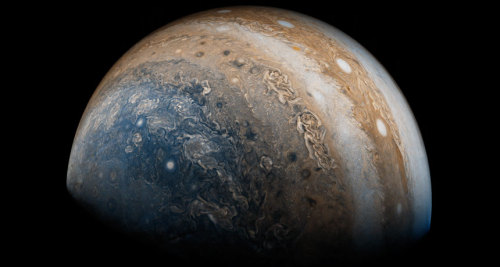









Jupiter Descending

Saturn by europeanspaceagency

Montage of Neptune and Triton by NASA on The Commons
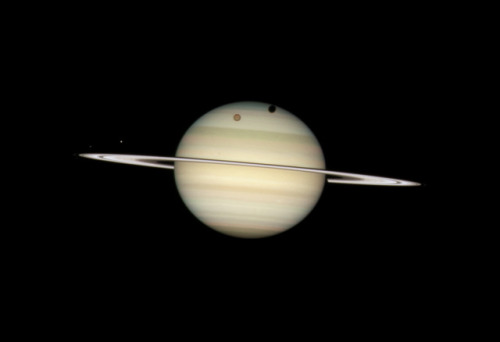
Saturn With Quadruple Moon Presence – Hubble Telescope










Should NASA Send New Horizons To A Nearby Star For Its Final Mission?
“Over the next million years, the Voyagers and Pioneers will approach numerous stars, but only at relatively large separations. The closest will be Pioneer 10, encountering HIP 1177795 in ~90,000 years from 0.75 light-years away. But New Horizons, unlike the others, still has significant fuel remaining. After encountering Pluto and Arrokoth, it may yet target another object in the outer Kuiper belt. Subsequently, it will eventually enter interstellar space, but can be boosted to approach future stellar targets.”
In the 1970s, four spacecraft were launched with speeds large enough that they would eventually escape the Solar System: Pioneer 10 and 11 and Voyager 1 and 2. In the 2000s, New Horizons became the fifth spacecraft that will leave the Solar System and enter interstellar space. But unlike the other four, it still has fuel remaining and could boost itself to alter its trajectory. In the aftermath of the ESA’s Gaia mission, we now can predict where more than a billion stars in the Milky Way will be located up to a million years in the future, raising the possibility that we could alter New Horizon’s trajectory to encounter another solar system in the distant future.
Should we do it? Of course we should! Come learn about this fascinating possibility today.
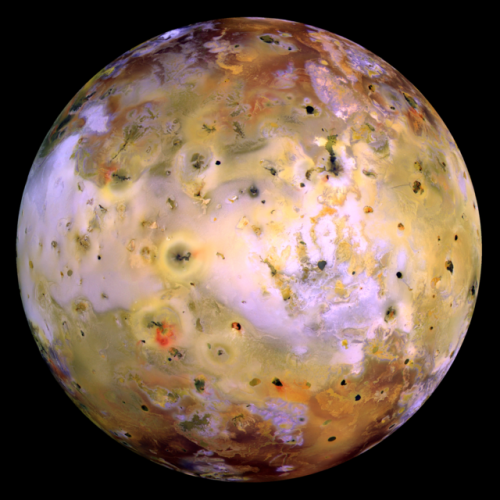
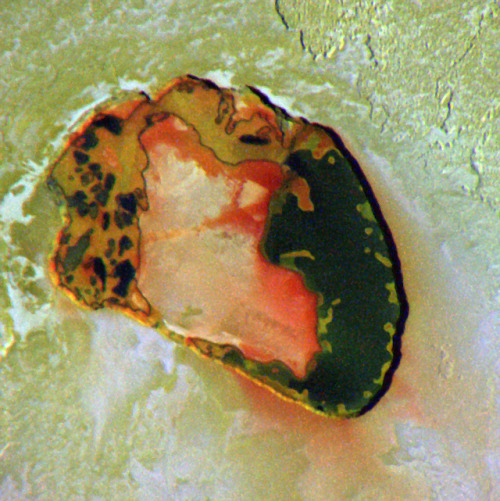
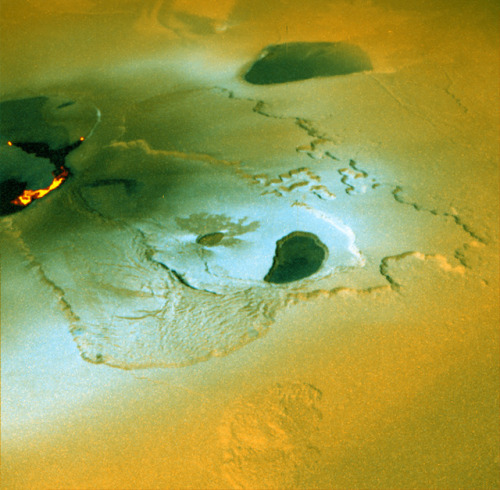
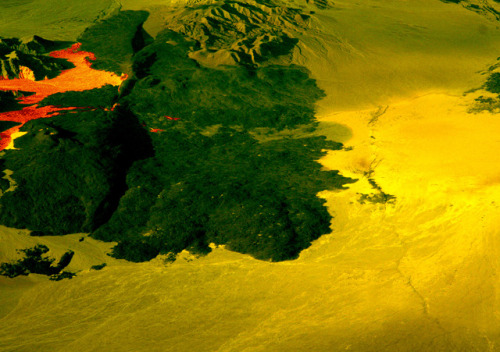
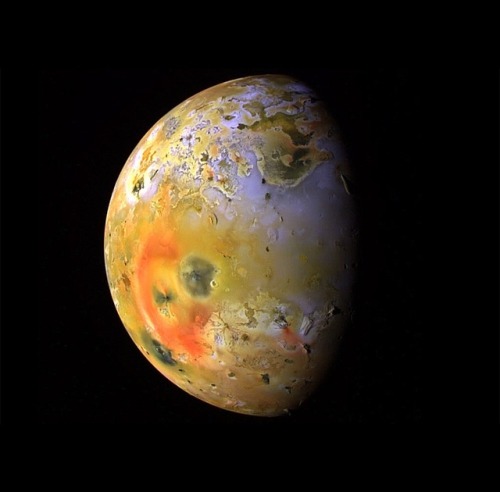
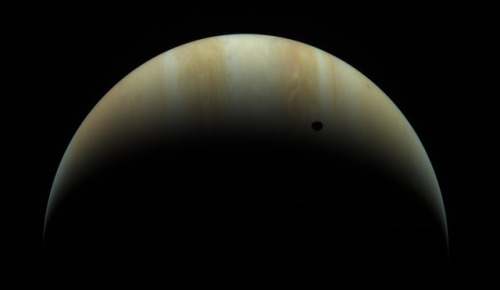
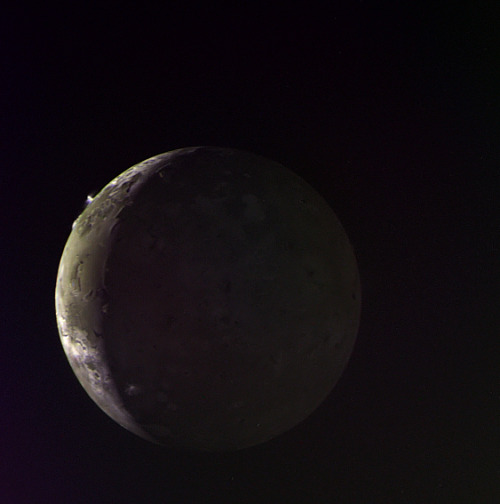
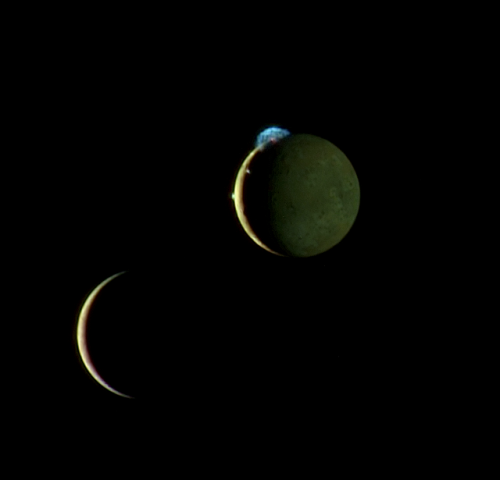
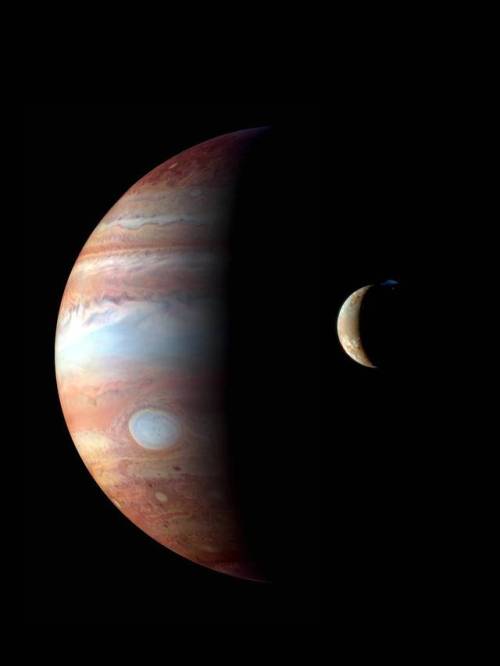
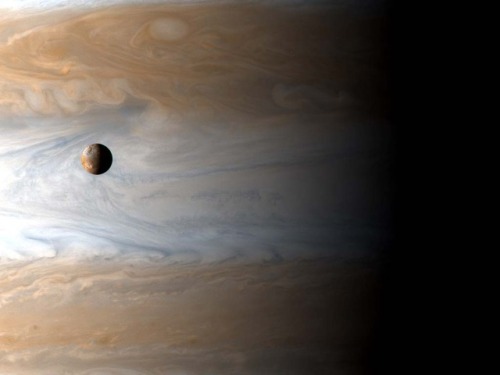
Io - The Volcanic Moon
Looking like a giant pizza covered with melted cheese and splotches of tomato and ripe olives, Io is the most volcanically active body in the solar system. Volcanic plumes rise 300 km (190 miles) above the surface, with material spewing out at nearly half the required escape velocity.
A bit larger than Earth’s Moon, Io is the third largest of Jupiter’s moons, and the fifth one in distance from the planet.
Although Io always points the same side toward Jupiter in its orbit around the giant planet, the large moons Europa and Ganymede perturb Io’s orbit into an irregularly elliptical one. Thus, in its widely varying distances from Jupiter, Io is subjected to tremendous tidal forces. These forces cause Io’s surface to bulge up and down (or in and out) by as much as 100 m (330 feet)! Compare these tides on Io’s solid surface to the tides on Earth’s oceans. On Earth, in the place where tides are highest, the difference between low and high tides is only 18 m (60 feet), and this is for water, not solid ground!
This tidal pumping generates a tremendous amount of heat within Io, keeping much of its subsurface crust in liquid form seeking any available escape route to the surface to relieve the pressure. Thus, the surface of Io is constantly renewing itself, filling in any impact craters with molten lava lakes and spreading smooth new floodplains of liquid rock. The composition of this material is not yet entirely clear, but theories suggest that it is largely molten sulfur and its compounds (which would account for the varigated coloring) or silicate rock (which would better account for the apparent temperatures, which may be too hot to be sulfur). Sulfur dioxide is the primary constituent of a thin atmosphere on Io. It has no water to speak of, unlike the other, colder Galilean moons. Data from the Galileo spacecraft indicates that an iron core may form Io’s center, thus giving Io its own magnetic field.
Io was discovered on 8 January 1610 by Galileo Galilei. The discovery, along with three other Jovian moons, was the first time a moon was discovered orbiting a planet other than Earth.

Eruption of the Tvashtar volcano on Jupiter’s moon Io, photographed by New Horizons.
Image credit: NASA/JPL/Galileo/New Horizons ( Stuart Rankin, Kevin Gill)
Source: NASA
-
 iknowaladygoodandevil liked this · 11 months ago
iknowaladygoodandevil liked this · 11 months ago -
 brotherjaybird liked this · 1 year ago
brotherjaybird liked this · 1 year ago -
 bronzecelestial liked this · 2 years ago
bronzecelestial liked this · 2 years ago -
 princesspink48484 reblogged this · 2 years ago
princesspink48484 reblogged this · 2 years ago -
 princesspink48484 liked this · 2 years ago
princesspink48484 liked this · 2 years ago -
 beomseokchae liked this · 2 years ago
beomseokchae liked this · 2 years ago -
 idee-montijo liked this · 3 years ago
idee-montijo liked this · 3 years ago -
 artistlearningsstuff liked this · 3 years ago
artistlearningsstuff liked this · 3 years ago -
 wachsurfer2018 liked this · 3 years ago
wachsurfer2018 liked this · 3 years ago -
 drewcifer4 liked this · 3 years ago
drewcifer4 liked this · 3 years ago -
 the-queer-spanish-inquisition liked this · 3 years ago
the-queer-spanish-inquisition liked this · 3 years ago -
 mrclaw61 liked this · 3 years ago
mrclaw61 liked this · 3 years ago -
 classygreenwarlock liked this · 3 years ago
classygreenwarlock liked this · 3 years ago -
 metalzoic liked this · 4 years ago
metalzoic liked this · 4 years ago -
 mythbookworm18 liked this · 4 years ago
mythbookworm18 liked this · 4 years ago -
 k-crimson liked this · 4 years ago
k-crimson liked this · 4 years ago -
 wakayume liked this · 4 years ago
wakayume liked this · 4 years ago -
 bridge-to-knowhere liked this · 4 years ago
bridge-to-knowhere liked this · 4 years ago -
 gerrytwin reblogged this · 4 years ago
gerrytwin reblogged this · 4 years ago -
 gerrytwin liked this · 4 years ago
gerrytwin liked this · 4 years ago -
 quamatoc reblogged this · 4 years ago
quamatoc reblogged this · 4 years ago -
 lyydt liked this · 4 years ago
lyydt liked this · 4 years ago -
 cliffsteele reblogged this · 4 years ago
cliffsteele reblogged this · 4 years ago -
 irishwhiskeyneatplease liked this · 4 years ago
irishwhiskeyneatplease liked this · 4 years ago